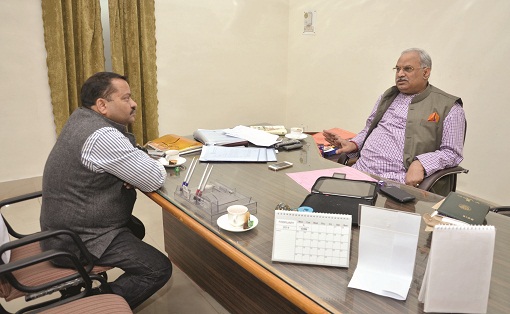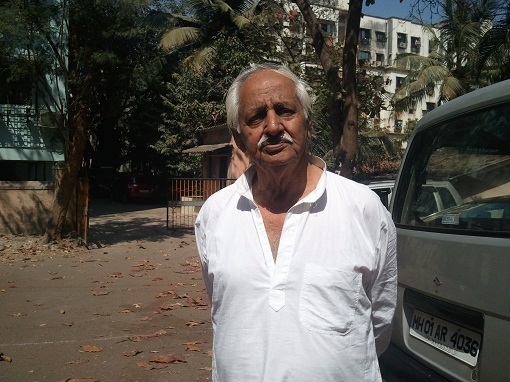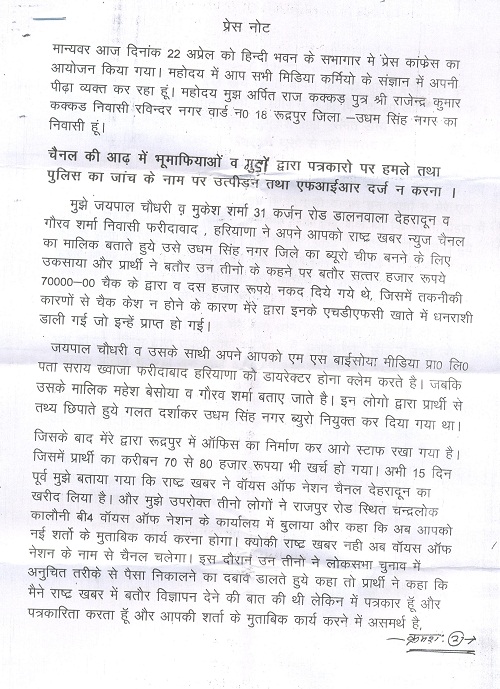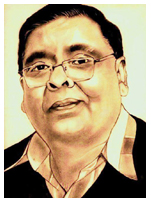As a journalist associated with television broadcast news for the last two decades, how and where does one begin talking about television broadcast journalism? As both a participant and an avid consumer of news, lines blur easily, making it extremely difficult to find any sense of objectivity.
But having “hung up my mike” in a manner of speaking, I believe the ringside view afforded to me both as a reporter and a desk hand privileges me with insights not easily available to the growing mass of critics and media sociologists struggling to make sense of prime time television – opinionated, loud, rude anchors, endless talking heads, studio-hopping experts, flashing graphics and even absurd soaked-in-theatre “live” visuals. All this is consumed by viewership, day after day, given the omnipresence of television in the intimacy of our living rooms.
A good starting point would be an observation made by the US regulatory authority, the Federal Communications Commission (FCC) which in a recent report said:
The Walter Cronkites and John Chancellors (both deceased, but widely accepted as America’s most credible TV journalists) are a dying breed. In many cases you don’t have journalists. You have performers.1
This observation, made in the backdrop of the financial meltdown in the US, accurately sums up the television scenario in India. Post-2008, there has been a profusion of studio-based “performers” rather than news professionals across India’s broadcast landscape, transforming the manner in which news content is packaged, delivered and consumed by the viewing audience.
The news studio has become the site for “manufacturing” news and consent on behalf of the beleaguered state. This is largely the product of an unprecedented financial crisis which has threatened media’s advertisement-based revenue model,2 forcing it to cut costs and increase dependence on the state, the financial market, and other cash-rich promoters who are jostling to move into, arguably, India’s most powerful medium. Taken together, these have ended up making the owners/promoters, rather than editors, the prime drivers of television news content – a point eloquently made by the latest Telecom Regulatory Authority of India (TRAI) report.3
Owners in the Studio
The Zee “extortion” case is perhaps the best illustration of the role of owners in the studio. The Hindi news network launched a shrill “probity” campaign against Congress Member of Parliament and steel tycoon Navin Jindal for allegedly using his clout to swing favourable deals in coal block allocations. Later, as it turned out, the campaign was eyeing Jindal’s riches, Rs 100 crore to be exact, as a price for rolling back the campaign. Ironically, the matter hit the headlines after two of the network’s editors were caught on hidden camera allegedly “extorting” money from Jindal officials. Later, both the editors, Sudhir Choudhary4 and Samir Ahluwalia spent nearly 20 days in Delhi’s Tihar jail. The Delhi police are now investigating the complicity of both the owners and the editors in the alleged extortion incident.5
In its brief history spanning not more than 20 years, the Indian television broadcast industry has been largely perceived as a handmaiden of the state owing to its emergence within the womb of Doordarshan (DD) – a legacy it still finds tough to live down. In the recent past, however, major private players especially from the non-media sector have also moved in on account of its growing commercial and political clout.
As one of the “midwives” who ushered in this change, former DD boss and secretary Information and Broadcasting (I and B), Bhaskar Ghose discusses pointedly in his book6 how the government sold airtime to private producers for an “irrationally modest” amount. The producers in turn not only charged the sponsors the sky but also sold approximately three to four minutes of free commercial time (FCT) to advertisers. Secondly, “the producer or the sponsor kept the copyright…repeats of popular serials meant paying a fortune (by DD) to the copyright holder.” Ghose mentions the “Ramayana” example where the producer retained all the video rights.7
Finally, as the Central Bureau of Investigation case relating to India’s premier news network New Delhi Television (NDTV) shows, there was extensive patronage and quid pro quo at play.8 The then director general DD, Rathikant Basu is alleged to have “manipulated” the placement of NDTV promoter Prannoy Roy’s pioneering programme, “The World This Week” (TWTW) in a “superior” category which, according to a report of Parliament’s Public Account Committee (PAC), caused the government a loss of Rs 3.52 crore. NDTV is also alleged to have wrangled more than $20 lakh in foreign exchange for the production of TWTW from the Ministry of Economic Affairs on Basu’s recommendation. Crucially, there was no attempt to figure out how the money was used. In its letter to the PAC, NDTV denied these charges,9 alleging that the I&B ministry had provided erroneous data.
But it is not just NDTV. Aaj Tak, India TV, News 24 are some of the other channels that have apparently drawn heavily upon DD’s fabled generosity. Of course, their rise and consolidation was a product of a number of other factors, chief among them being conditions of economic boom and early bird advantage.
In the post-2008 phase, the state-media nexus thrives. But a little differently. The state appears to be actively playing stranger to the growing consolidation underway in the media space on the back of a general slowdown and steadily deteriorating fortunes of media networks.10
Newsroom Meltdown
Post the economic meltdown, the most grievous blow has been suffered by two key institutions that are lynchpins of news systems anywhere in the world, the editor and the reporter. Increasingly, the locus of power in news operations has shifted to the studios – the promoters and their hand-picked editors. This has resulted in a near complete centralisation of news-gathering operations. The shift in power equations chiefly reflects the political sensitivities of the emerging news ecosystem which calls for the involvement of the promoters in cost-cutting operations at various levels on a day-to-day basis (from transportation, outstation shoot, type of hotel accommodation, buying footage, retrenchment, etc).
Cost-cutting apart, every day the promoter walks the thin line balancing several conflicting interests such as businessmen and politicians of all hues in an era of coalition, by no means an easy task in the relentless 24×7 news cycle. A pliable editor provides a way out by not merely filling in but also ensuring that a chain of command is created whose primary mandate is to protect the promoter’s interests. In virtually every newsroom (both in Hindi and English news networks), there is a long unwritten list with regard to covering politicians – depending on their proximity to the promoter (the Ambanis and the Gandhi family, for example, are a complete no-no in most newsrooms).11
With most media organisations listed on the stock exchange, the opaque and murky world of high finance is also a powerful consideration colouring editorial judgments. As Moneylife, an online portal edited by leading business journalist Sucheta Dalal (who exposed the Harshad Mehta securities scam in 1992), comments in a write-up entitled “Glamour Stocks Turn Ugly”:
Look at the shareholder returns of some of these glamour stocks over the past five years. NDTV got listed in 2004 and is trading below its listed price after seven years. It has given a negative return of 19% compounded in the past five years and a total shareholder return of negative 66% for the same period. Its viewership claims like those of all TV channels are impossible to verify. Its credibility is at a nadir (after recent phone-tapping controversy) and its finances are in a mess…(But) every few months, the financially beleaguered NDTV manages to get ‘strategic’ investors with deep pockets and top-flight private equity investors to step in and pick up big chunks of its equity at fancy valuations. In the third week of June (2011), D E Shaw, a $20 billion hedge fund…picked up a 14.2% stake in NDTV providing an exit to Goldman Sachs, another blue chip investor…Interestingly, despite the D E Shaw acquisition, the stock has barely moved. As happens with glamour stocks, D E Shaw could be a front for someone else. Coincidentally, D E Shaw has a tie-up in India with (Mukesh Ambani’s) Reliance Industries to sell financial services.12
(The write-up also questions other “glamour stocks” – CNBC-TV18, Kingfisher Airlines.)
Given the changing political economy of the news ecosystem, is it any surprise that political reporting is as good as dead? In my experience of reporting politics, stories only emerged from the “top”. The reporter’s story was only aired if it coincided with the carefully crafted and sanitised editorial line of the news network.
With the studio as the site for “manufacturing” news, the reporter has become marginal to the news-gathering operations. Digital technology-driven graphics and visual effects are increasingly replacing pictures across most of the networks (compare the BBC and our networks for a “graphic” understanding of my point). Stories can now be told with graphics and sophisticated animation. Eclipse of the visual element has obviated the need for skilled technicians and even senior journalists, large numbers of whom have been retrenched since 2008. They have been replaced by young reporters who can work long hours at half the salaries of their senior counterparts and are easily manageable. The progressive deskilling of media labour has been accompanied by the scrapping of longer format, investigative reports and in-depth stories. The only skill expected of broadcast journalists is the ability to cover events and uplink sound bites. The reporter has never been as close to redundancy in India as he/she is today.
The wellsprings of the “dumbing down” culture of TV broadcast media lie in the political economy of the contemporary news industry.
Studio as Crucible of News
The privileging of the studio/anchor/editor means “news from the vantage point of a studio”. The very definition of “news” as the “first draft of history” recorded by journalists in the most “objective” manner has been turned on its head. Loosely put, “news” has become the “subjective” fact filtered and processed by the promoter whose complicity is paramount in the very act of airing a particular news.
Therefore, the task remains to pin down the definition of news. In other words what constitutes news, post-meltdown?
“News” is largely dramatic and prolonged, live, unmediated footage. This method of news delivery is cost-effective (you only need a skeleton staff) and ensures the centrality of the anchor/studio as the absolute interpreter of sound bites and visuals. Above all, it gets viewers in droves. The Anna Hazare movement in 2011 sent the television rating points (TRP) graph northwards at the expense of the Indian Premier Leage (IPL) cricket and even soaps and serials.13
“News” bulletins are also increasingly “wire” fed or news agency driven – largely a consequence of outsourcing of news-gathering operations. The Asia News International (ANI), which also provides feed to Reuters, leads the pack. But smaller wire services like United News of India (UNI) and Network 1 News and Information Syndicate (NNIS), providing multi-lingual feeds, have recently emerged as competition. A disturbing fallout of this remains homogenising of news content.
Thirdly, digital platforms have emerged as an important “source” for “constructing” news. The trend, which largely began with the Anna Hazare movement, currently boasts of a galaxy of senior politicians (L K Advani, Narendra Modi, Shashi Tharoor, Digvijay Singh and even the Prime Minister’s Office (PMO) are some notable examples) whose posts are regularly followed and integrated within the very definition of news. Both Twitter and blogs afford politicians the luxury of commenting only when there is a need to “set the agenda” without the discomfort of counter-questions from pesky reporters.
“News” could also mean sensational footage uplinked by the stringer (they have replaced reporters across large swathes of “non-TRP” states like Jharkhand, Chhattisgarh and the entire north-east) from some “obscure” corner. The footage could be genuine or rigged. The Naxalite attack on Central Reserve Police Force jawans in Dantewada, for example, falls in the former category. But the “live” footage of the public molestation of a girl in Guwahati in July last year falls in the latter category. The Guwahati episode was “manufactured” by a local news network and the gut-wrenching unedited footage was fed into the sensation-seeking “national” news networks. Both examples performed one single function – they briefly “mainstreamed” marginal India even though the image was distorted and one-dimensional.
In a scenario where networks are on crutches (i e, minus the foot-slogging reporters), “news” is largely what is being shown on a rival network. To anyone familiar with TV newsrooms, collective shouts of what a rival channel is showing, followed by urgency and anxiety to replicate the same on their network is the most prevalent way to “construct” news. That explains to a great extent the depressing sameness in news prime-time content.
Metaphor for State
Studios have increasingly become a metaphor for “state”. A studio is the site where “consent” is manufactured on behalf of the existing power relations. Herman and Chomsky term this the “propaganda model”,14 though their context is different. The model has inbuilt filters that ensure marginalisation of “dissent” and allows the “government and dominant private interests to get their messages across to the public”.15 They enumerate five filters, the most relevant for us include wealth and profit orientation of the dominant media, advertising revenues as their incomes, and reliance on government, corporate sector and sundry “experts” for information.
Every issue plays itself out within a paradigm of binary oppositions with the idea being not to resolve the issue for the audience in a meaningful manner but just to provide a spectacle, a simulated cockfight if you will in which the style, the “performance” is far more valuable than content. This peculiar entertainment paradigm, which has a daily star cast of Bharatiya Janata Party (BJP) and Congress “performers” (never mind the large number of regional parties who dominate the political landscape) is notable for the “manufactured rage”, posturing, histrionics largely at the behest of the anchor who is at once an entertainer, inquisitor and the self-appointed voice of the “nation”, all rolled into one. Such absurdity typical of prime-time television, night after night, stretches the viewers’ credulity and ends up taking any meaningful “politics” out of the issue on the table.
As Herman and Chomsky have shown, even the “resources” for such discussions are essentially “statist”, i e, either sourced from the government or private corporations. The term “resources” is used in an extended sense to include data, statistics or even studio experts.16 In the context of our studios, “experts” are invariably former state functionaries such as retired army generals (putative specialists on Pakistan, China and the north-east) or bureaucrats, “senior journalists” (from Home and Defence beats), socialites (Shobhaa De, Suhel Seth) and even civil society types who double up as vox populi (since the “aam aadmi” is way too “lowly” to fit into the prime time rage-manufacturing factories).
Conclusions
The profound and disturbing intimacy between media promoters and corporations in general and media networks and the political establishment in particular has come to acutely characterise the state of TV reportage and electronic broadcasting in India, especially in the post-2008 meltdown period.
Perhaps the single most disturbing development has been the “top-down” construction of news. As sundry corporations move in to take effective control of news-gathering operations, newsrooms are increasingly mimicking corporate management styles (designations like chief executive officer, president, vice-president, etc) with hire and fire as the driving principle. And while some of this prosperity has translated into better salaries and perks for journalists (and other personnel), news operations have ceased to be democratic. Today it would be difficult if not impossible to find editorial and news floor meetings where ideas and “angles” of the story are debated unencumbered. All this has made TV broadcast news an anomaly. It has largely ceased to serve as a mirror reflecting the fundamental changes playing out in the nation’s society and politics. News broadcasts are more like isolated, noisy, floating bubbles divorced from the deeper rumblings of a rapidly changing order.
Notes
1 The Information Needs of Communities – The Changing Media Landscape in a Broadband Age, Steven Waldham et al, FCC 2011.
2 The latest “FICCI-KPMG Indian Media and Entertainment Report 2013”, report bears this out. The growth in revenue advertising is down to 9% in 2012, from 12.6% in 2011. It was 17% in 2010. As the KPMG Head, Media and Entertainment, Jehil Thakkar said, “On the business front it was an extremely challenging year (2012), especially on advertising. It is probably one of the worst years for the advertising industry has had in a decade with the exception of the film industry.” see, https://www.youtube.com/watch?v=1Pn6b_1H164
3 The report says, “There are many ways in which owner can influence newspaper (television in our case) without giving a direct instruction. More common is the indirect influence that an owner can have. Usually the appointment of an editor is down to the owner of that paper. This gives the owner a clear mechanism of influence over his title’s editorial agenda. Once an editor is in place it is usually the owner who has the power to fire him so even when the editor and the owner have different views there is considerable incentive for the editor to avoid upsetting the owner.” TRAI Report, 2013, p 44.
4 Sudhir Choudhary earlier CEO of Live India TV, a Hindi news channel, enjoys the dubious distinction of presiding over a network whose licence was revoked in 2007 after it showed a fake sting operation involving a Delhi government schoolteacher. The teacher, Uma Khurana, was wrongly shown as pushing her student(s) into prostitution. Choudhary was lucky to come out unscathed as the teacher withdrew her case. But the Choudhary case begs the question why such a hugely compromised professional was made a member of the Broadcast Editors Association, and Editor of Zee news network in the first place.
5 The Niira Radia CDs are, till date, the best example of media-politician-corporate nexus. One of the CDs, which did not receive the kind of traction it deserved, was the conversation between the News X CEO Jehangir Pocha and Radia where the former is heard asking her to arrange for the salaries of his employees that had been evidently delayed. Radia assures him that it would be done though she does not reveal the benefactor. The tone of the conversation clearly suggests that this was not a one-off request. It hardly beggars mentioning that none of this would have been without editorial strings attached. Transcripts, Outlook, 27 December 2010 http://www.outlookindia.com/article.aspx?269686
See, for instance, the various reports by the Telecom Regulatory Authority of India (TRAI) Reports, 2009, 2013. Also see the “Study on Cross Media Ownership in India”, Administrative Staff College, Hyderabad. All these reports have warned the government about the adverse fallout of growing media consolidation.
6 Doordarshan Days, Bhaskar Ghose, Penguin, Viking, 2005.
7 Ibid: 43.
8 See Outlook, “Star Crossed”, Charulata Joshi, 1 September 1997, http://www.outlookindia.com/printarticle.aspx?204133, accessed on 21 February 2013.
9 The Indian Express, 24 August 1997, http://www.financialexpress.com/old/ie/daily/19970824/ 23650043.html, accessed on 18 March 2013.
10 Reliance group’s investment in CNBC-TV 18 and Eenadu group remains the best example. Recently there have been media reports that the Aditya Birla group is looking to up its stake in the India Today group from 27.5% to 51%.
11 Yogendra Yadav has talked at length about the Omerta code relating to the Gandhis and Reliance. See, “This Shadow of Exception”, Yogendra Yadav, The Indian Express, Friday, 12 October 2012, accessed on 30 January 2013.
12 Moneylife, 25 August 2011, accessed on 26 January 2013.
13 See, for instance, “Now Anna Hazare Is a Serial Killer”. The article says, “While the TRPs of news channels have almost doubled since Anna Hazare’s call for protest, the TRPs of reality shows and soaps have shown a dip in the same period”, The Times of India, 26 August 2011. http://articles.timesofindia.indiatimes.com/2011-08-26/tv/29930758_1_trp…, accessed on 21 April 2013.
14 See Manufacturing Consent, The Political Economy of Mass Media, Edward S Herman and Noam Chomsky, Vintage Books, London 1994, pp 2-35. The “propaganda model” which assumes a top-down flow of information and culture to apparently passive receiving audiences is a contested model. Much before Herman and Chomsky put forth this model, the “Culture Study” theorists in Britain in the 1950s had argued for the audiences’ ability to interpret media messages subjectively. Stuart Hall’s path-breaking essay, “Encoding, Decoding” written especially with television as popular culture in mind persuasively argued that the audience often “negotiates” the dominant coded message. He also identifies an “oppositional code” implying that the audience in cases can simply reject a message purveyed by the media. See The Cultural Studies Reader, Simon During, third edition, Routledge, 1993, pp 478-87. In India, there has been no study of audience response to television.
15 Ibid: 2.
16 Herman and Chomsky op cit, pp 18-25. Also see Government of India, “Report of Sectoral Innovation Council”, Ministry of Information and Broadcasting, July 2012. The situation is so abysmal that the report which has called for a “national media policy” is based almost entirely on data generated by private agencies. It candidly admits, in fact boasts, that “the Council has gone through many articles and reports published by Industry Associations like FICCI, CII and ASSOCHAM, consulting agencies like PriceWaterhouse Coopers, Ernst and Young and KPMG…”
Writer Sandeep Bhushan is Former NDTV and Headlines Today reporter, now an academic at the Jamia Millia Islamia.





